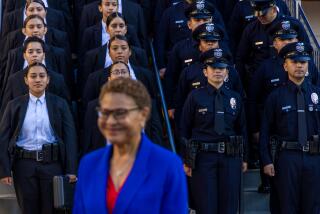LAPD moves 150 officers to deal with freed prisoners
- Share via
The Los Angeles Police Department will remove 150 officers from patrol and other assignments to deal with the fallout from a state-mandated plan to reduce prison overcrowding, a move that Police Chief Charlie Beck said will slow response times to 911 calls.
Beck and Mayor Antonio Villaraigosa joined forces Monday to criticize the state’s attempt to relieve severe prison overcrowding, saying it has unfairly saddled the LAPD with a burden that the department does not have the resources to address. They warned that it poses a risk to public safety and threatens to reverse the falling crime rates Los Angeles has experienced in the last decade.
The plan, which went into effect Saturday, shifts responsibility for thousands of inmates and ex-convicts from state to county agencies.
As part of that change, the LAPD and other local police departments will have to assume a leading role alongside the county’s probation officers in keeping tabs on an escalating number of ex-convicts who otherwise would have been under the watch of the state’s parole department or behind bars, Beck said. By year’s end, the LAPD is expected to be tracking 4,200 people, according to figures released by the mayor’s office.
Unlike the state’s parole officers, county probation staff are not typically armed nor are they adequately trained to deal with potentially violent ex-inmates, Beck said. As a result, Beck said, LAPD officers will need to take on much of the workload — for example, making house calls to check on whether the newly arrived offenders and parolees are in compliance with the terms of their release.
Beck declined to speculate on how much longer it would take officers to respond to emergency calls. To minimize the effect, Beck said he would try to place officers who are on desk jobs or in specialized assignments back into the field.
That could prove difficult, however, because Beck has already made several rounds of such moves and the number of officers available is limited. The LAPD has about 9,900 officers
Beck speculated that the increased number of ex-convicts walking city streets could lead to about 3,000 more serious crimes committed — about a 3% rise. The city has experienced a long and steady decline in all categories of crime over the last decade.
Beck and Villaraigosa, along with City Controller Wendy Greuel and gang expert Connie Rice, used a news conference to rebuke Gov. Jerry Brown and state legislators for a prison realignment plan that leaves the city to fend for itself.
Sacramento, the mayor said, is not providing “a single dollar to help with the burden. This is not alignment, this is a recipe for making the problem much worse.”
State officials rejected the criticism, saying that the mayor and LAPD should be looking to county officials for some of the $124 million the state has allocated to Los Angeles County to help offset the program’s costs. “It is up to each county how they want to manage their offenders and handle realignment,” said Terry Thornton, a representative of the Department of Corrections and Rehabilitation.
That won’t do, Beck said. The county’s allotment “isn’t enough to do what has been required of them much less our piece…”
Gil Duran, an aide to the governor, said concerns should have been raised before the plan went into effect and he accused the mayor and Beck of political posturing. “We just saw the mayor last week and he didn’t say a peep about public safety. He expressed his support for a bill to widen bike lanes, but he didn’t bring up realignment.”
The prison reform is a result of budget pressures and a U.S. Supreme Court decision that required the state to lower its prison population by 30,000 inmates due to overcrowding. Under the new law, prisoners currently serving time for nonviolent and non-sex-related crimes will be kept in county jails instead of going to state facilities. And, when released, those prisoners will be left for county probation to monitor.
Beck’s and Villaraigosa’s remarks were the latest in a growing chorus of complaints from local officials frustrated by the reform effort.
Los Angeles County Dist. Atty. Steve Cooley has criticized the plan because he believes it will increase crime and lead judges to impose shorter sentences for criminals because they know the county already has overcrowded jails. On Monday he reiterated his concerns, saying, “We are going to do our best to make this horribly flawed program work. It is easily predictable that crime across the board will increase substantially.”
Los Angeles County Sheriff Lee Baca, who has been less critical of the plan, believes he will need 56 deputies and supervisors to handle the increased probation responsibilities, sheriff’s officials said. Baca, however, has decided to wait until he learns whether county supervisors will give him the funds he needs to make the changes. Currently, only 10 deputies and five supervisors are working on the issue.
Long Beach Police Chief Jim McDonnell said his department, like many throughout the county, is struggling to get a reliable count of how many parolees it will have to monitor. “It’s hard to strategize,” McDonnell said.
Long Beach, like most jurisdictions, has significantly cut its budget amid the state’s fiscal woes, driving down the number of police officers who potentially could monitor parolees. Two years ago, the city had money for 1,020 officers. This year, the number has fallen to 851.
McDonnell said the realignment plan could force his department to dramatically reassess its crime-fighting strategies. With an influx of released felons, he said, it could become difficult to focus on smaller, quality-of-life crimes. “We are going to have to play it by ear,” he said.”
Times staff writer Jack Leonard contributed to this report.
More to Read
Sign up for Essential California
The most important California stories and recommendations in your inbox every morning.
You may occasionally receive promotional content from the Los Angeles Times.














